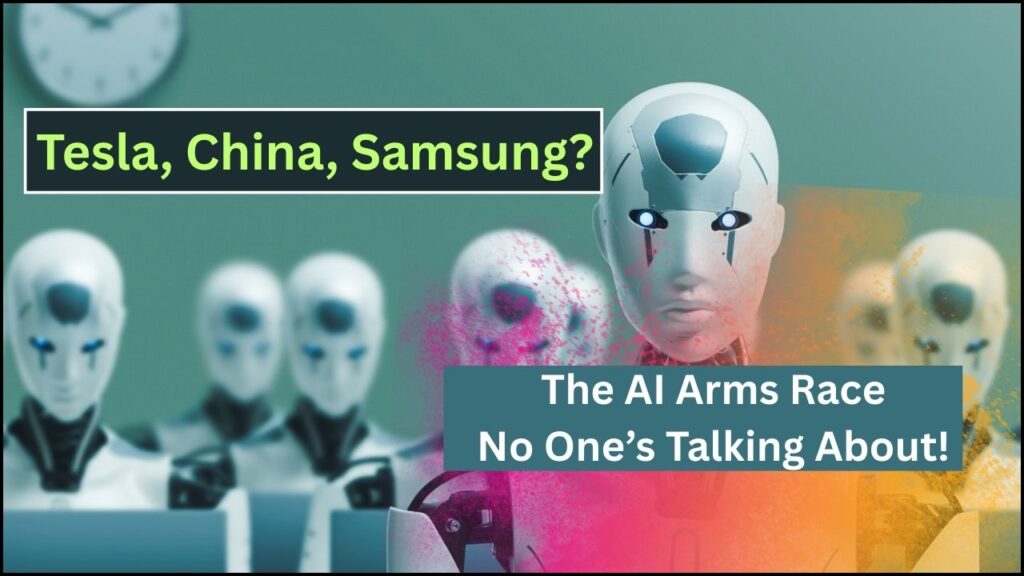The AI Arms Race: Artificial Intelligence (AI) is no longer just a tech buzzword — it’s a global arms race. While companies like OpenAI and Google often dominate headlines, Tesla, China, and Samsung are quietly rewriting the rules of AI. These three powerhouses are investing billions into infrastructure, AI chips, consumer integration, and robotics. Their efforts could reshape how we live, work, and interact with technology.

In this article, we take an in-depth look at how each player is making strides in the AI arms race, the impact this has on different industries, and how professionals and businesses can stay ahead of the curve in this fast-evolving space.
The AI Arms Race
| Topic | Details |
|---|---|
| Tesla | Investing in Dojo supercomputer, AI chips, autonomous driving, and humanoid robots. |
| China | Leading in AI hardware, robotics, and domestic chip production; shifting focus to AI inference. |
| Samsung | Integrating AI into smartphones and consumer devices through Galaxy AI and Gauss. |
| Market Impact | AI computing market expected to reach $407 billion by 2027 (Statista). |
| Official Resources | Tesla Autopilot, Huawei AI Strategy, Samsung Newsroom |
The AI arms race among Tesla, China, and Samsung is reshaping global tech leadership. Tesla is betting on autonomy and robotics. China is focused on scalable AI hardware and infrastructure. Samsung is pioneering consumer-friendly AI solutions. Each approach addresses different aspects of the AI value chain.
As the race heats up, it will determine who controls the next generation of innovation. For businesses, professionals, and consumers alike, staying informed and agile will be key to thriving in the AI-powered future.
What Is the AI Arms Race?
The AI arms race refers to the fierce competition among countries and corporations to dominate artificial intelligence. It’s not just about who builds the smartest AI model but also who controls the infrastructure, chips, data, and distribution channels. While military applications still matter, this race is largely about economic supremacy, industrial transformation, and technological independence.
Why Is It So Important?
AI is transforming sectors like healthcare, agriculture, education, and logistics. According to McKinsey, AI could add $13 trillion to the global economy by 2030. That kind of potential has triggered an investment boom. Nations see AI as critical to national security and innovation, while companies see it as the next wave of automation and intelligence.
Some major developments include:
- AI helping radiologists detect diseases earlier.
- AI bots conducting legal research in minutes.
- AI-enhanced supply chains cutting costs and delivery times.
AI’s widespread adoption will create winners and losers depending on how quickly and wisely they adapt.
Tesla’s AI Vision: Beyond Self-Driving Cars
Tesla may be known for electric cars, but behind the scenes, it’s building an AI-first company.
Full Self-Driving (FSD) and Dojo Supercomputer
Tesla’s Full Self-Driving (FSD) system uses real-time AI to interpret surroundings and make driving decisions. Supporting this tech is Dojo, a next-gen supercomputer custom-built for AI training.
- Dojo replaces Nvidia GPUs with Tesla’s own AI chips, reportedly 20% more power-efficient.
- Elon Musk estimates that Dojo could be a $1 billion revenue stream by the end of 2025.
- Tesla trains AI on over 1 million miles of driving data per day.
This infrastructure allows Tesla to iterate faster, improve performance, and move closer to full autonomy. Unlike competitors relying on LIDAR, Tesla depends purely on camera-based vision.
Meet Optimus: Tesla’s Humanoid Robot
In addition to FSD, Tesla is venturing into robotics. Optimus, their humanoid robot, is designed to perform basic factory tasks and, eventually, household chores. Musk envisions a world where Optimus units take over repetitive and dangerous jobs.
The robot has already demonstrated simple mobility and object manipulation. However, production is delayed due to China’s export restrictions on rare-earth magnets essential for actuators.
“We’re waiting for export licenses from China to proceed with actuators,” Elon Musk told Business Insider.
This delay highlights the geopolitical risks embedded in the AI hardware supply chain.
China’s AI Strategy: Inference, Hardware, and Robotics
China views AI as a cornerstone of its future economy and sovereignty. While the West emphasizes building large AI models, China is focused on scalable deployment through inference and infrastructure.
Domestic Chip Development
U.S. sanctions have cut off Chinese companies from Nvidia’s high-performance AI chips. In response, China is ramping up local production. Key players like Huawei, SMIC, and Cambricon are developing powerful alternatives.
- Huawei’s Ascend chips now power major cloud services in China.
- China’s State Council plans to reach 70% chip self-sufficiency by 2028 (Financial Times).
- Several Chinese firms have launched AI accelerators optimized for inference, not just training.
These efforts are not only about avoiding U.S. sanctions but also about reducing costs and gaining control over critical technologies.
Robotics Boom
China is leading the world in humanoid robot development, backed by over $10 billion in public-private investments.
- Companies like Unitree, Fourier Intelligence, and Xiaomi are building affordable robots for industries ranging from eldercare to logistics.
- China now files more robotics-related patents than the U.S., EU, and Japan combined.
The goal is to integrate robotics into everyday life and manufacturing. China wants robots in schools, hospitals, and factories, functioning as both workers and assistants.
Samsung: AI in the Palm of Your Hand
While Tesla and China aim for infrastructure dominance, Samsung is revolutionizing consumer electronics through embedded AI.
AI Features in Smartphones
Samsung’s Galaxy AI includes groundbreaking features that enhance usability:
- Live Translate: Real-time language translation during calls.
- Photo Assist: Smart object removal and background fills.
- Voice Clarity: Noise-free voice calls and recordings.
These features are powered by Samsung Gauss, a proprietary generative AI model. The AI runs both on-device and in the cloud, offering seamless user experiences while prioritizing privacy.
Democratizing AI for Consumers
Samsung’s vision is to make AI as common as a flashlight on a phone. Their approach focuses on everyday usability rather than cutting-edge experimentation.
“Gauss is our step towards smarter, more helpful devices for everyone,” said Won-Joon Choi, EVP of Samsung Mobile.
Samsung has also hinted at expanding Galaxy AI to appliances, wearables, and smart home ecosystems. That means your fridge, TV, and watch could soon be powered by AI.
What This Means for Professionals and Businesses
Opportunities
This AI race presents exciting prospects across industries:
- Developers: Need to master tools like TensorFlow, PyTorch, and embedded AI systems.
- Startups: Can offer niche AI services for healthcare, education, or logistics.
- Corporations: Have new automation and customer personalization tools at their fingertips.
- Investors: Sectors like semiconductors, AI chips, and robotics present high-growth opportunities.
Challenges
- Regulations: Different countries have different views on data privacy, surveillance, and ethics.
- Talent Gap: AI specialists are in short supply; global competition for skilled workers is fierce.
- Supply Chain Risks: Reliance on certain countries for chips and rare-earth elements could backfire.
Business leaders should prioritize AI readiness, evaluate cost-to-implement ratios, and monitor evolving regulations.
Grok 3 AI Launch Begins – Will This Redefine Artificial Intelligence?
iOS 18.3 Sets the Stage for Apple Intelligence – The Big Moment Explained
FAQs About The AI Arms Race
Why is China focusing on AI inference instead of training?
Training large models requires immense power and hardware, which are restricted due to export controls. Inference is lighter on resources and faster to deploy, making it more practical for businesses.
What makes Tesla’s Dojo different from other supercomputers?
Dojo is optimized specifically for Tesla’s vision-based AI training. It uses custom-designed chips that offer high-speed, low-power performance without relying on traditional GPU architecture.
Is Samsung building its own AI models like OpenAI?
Yes. Samsung’s Gauss model is designed for mobile and consumer use cases. While it isn’t as large as GPT-4, it’s optimized for real-time tasks like language translation, image editing, and smart automation.
How will this AI race affect everyday people?
The benefits include:
- Safer roads through self-driving cars
- Smarter phones with real-time features
- Faster healthcare diagnostics
- Personalized online shopping and education
It will also challenge jobs, privacy norms, and our dependence on technology.








